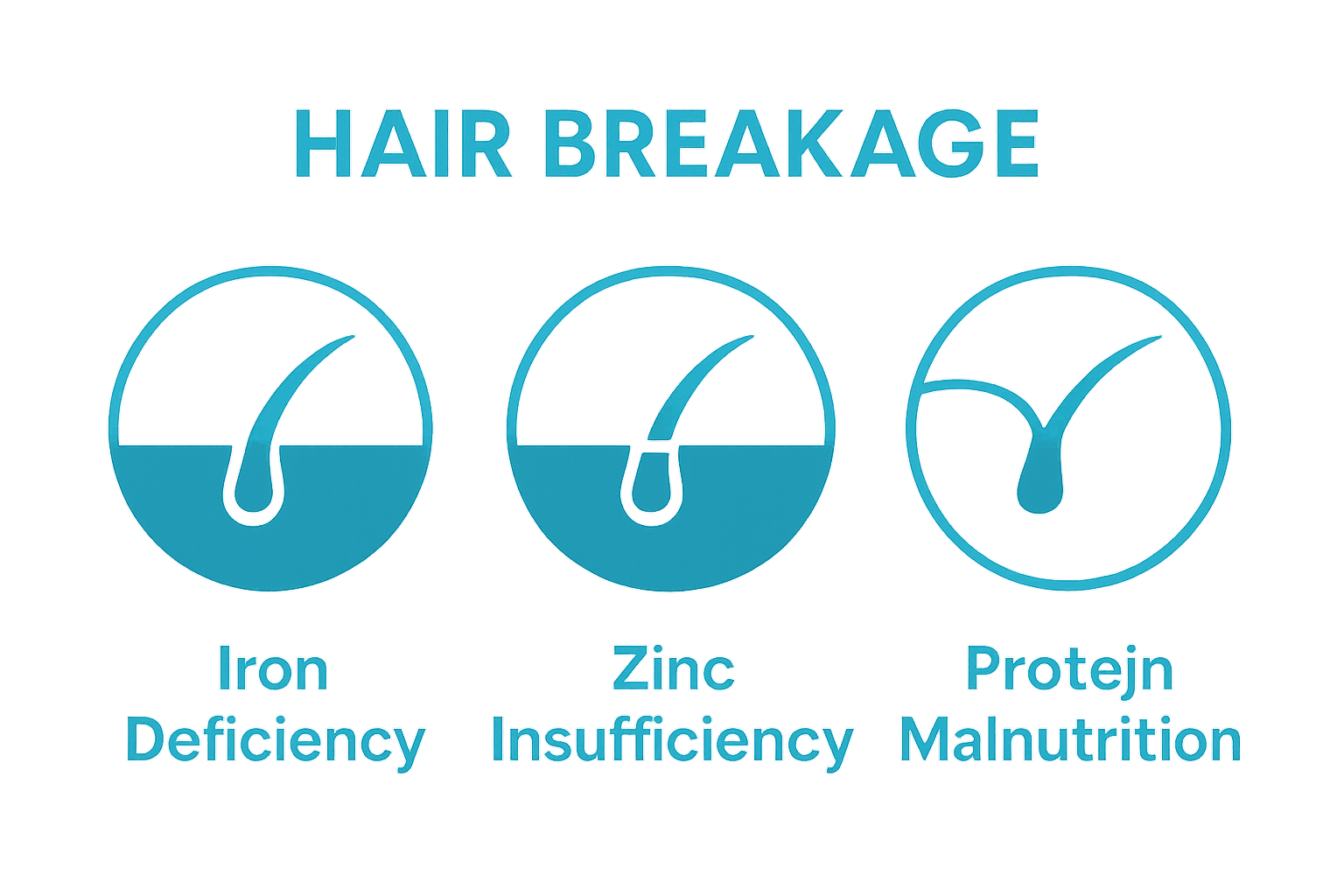Blog
Learning Materials
Understanding Hair Breakage Medical Causes Explained
Updated: September 10, 2025

Hair breakage can leave even the healthiest hair looking thin and tired. Most people blame split ends or rough brushing and move on. But the real story goes much deeper. Medical conditions and nutrition deficiencies often have a much bigger impact on hair breakage than everyday styling habits. Surprised? Sometimes, breakage is your body's way of flagging hidden health issues. Discover what your hair might be trying to tell you.
Table of Contents
- What Is Hair Breakage And Its Causes?
- The Medical Conditions Linked To Hair Breakage
- Nutritional Factors Contributing To Hair Weakness
- Hormones And Their Impact On Hair Health
- Understanding The Role Of Stress In Hair Breakage
Quick Summary
| Takeaway | Explanation |
|---|---|
| Hair breakage is not hair loss. | Hair breakage involves physical damage to hair strands, not the shedding of hair follicles. |
| Nutritional deficiencies weaken hair. | Insufficient iron, zinc, and protein impair hair health and strength, increasing breakage risk. |
| Hormonal imbalances impact hair health. | Conditions like thyroid dysfunction can alter hair growth cycles and decrease structural integrity. |
| Stress contributes to hair breakage. | Chronic stress disrupts hormone production and hair follicle function, worsening structural damage. |
| Seek professional guidance for hair issues. | Consulting healthcare professionals can help identify underlying causes of hair breakage and provide tailored solutions. |
What is Hair Breakage and Its Causes?
Hair breakage represents a complex hair health condition where the hair shaft physically fractures or splits prematurely, disrupting natural hair growth and appearance. Unlike typical hair shedding, which involves complete hair follicle detachment, breakage occurs along the hair strand itself, creating visible damage and potential long-term hair structure complications.
The Structural Mechanics of Hair Breakage
At its core, hair breakage happens when the hair's protective outer layer (cuticle) becomes compromised. Hair strands are composed of keratin proteins that form intricate structures providing strength and flexibility. When these protein bonds weaken or become damaged, the hair becomes susceptible to fracturing under minimal stress. Research from the National Institutes of Health indicates that multiple factors contribute to this structural degradation:
- Mechanical stress from aggressive brushing
- Chemical treatments disrupting protein structures
- Nutritional deficiencies affecting hair protein synthesis
- Environmental factors like extreme temperatures
Medical Underlying Causes of Hair Breakage
Several medical conditions can trigger hair breakage beyond external damage. Hormonal imbalances, autoimmune disorders, and metabolic disruptions directly impact hair protein production and strand resilience. Thyroid dysfunction, for instance, can significantly alter hair growth cycles and protein metabolism, leading to increased fragility.
Understanding your specific hair breakage pattern is crucial. Read more about identifying personalized hair health indicators to develop targeted intervention strategies. By recognizing the intricate relationship between medical factors and hair structural integrity, individuals can take proactive steps toward maintaining robust, healthy hair.
The Medical Conditions Linked to Hair Breakage
Medical conditions can significantly impact hair health, creating complex pathways of hair breakage that extend far beyond surface-level damage. Underlying health disorders frequently disrupt normal hair growth mechanisms, transforming seemingly routine hair maintenance into a challenging diagnostic journey.
Endocrine and Metabolic Disorders
Hormonal imbalances represent a primary catalyst for hair breakage. Thyroid dysfunction emerges as a critical factor, where both hypothyroidism and hyperthyroidism dramatically alter hair protein metabolism. According to research from the Mayo Clinic, these conditions can trigger:
- Accelerated hair thinning
- Increased hair fragility
- Disrupted hair growth cycles
- Reduced keratin protein production
Autoimmune disorders like lupus and alopecia areata further complicate hair structural integrity by attacking hair follicles and disrupting natural regeneration processes.
These conditions create an inflammatory environment that weakens hair strands from their foundational roots.
Nutritional and Systemic Health Challenges
Nutritional deficiencies play a profound role in hair breakage. Iron deficiency anemia, zinc insufficiency, and protein malnutrition directly impair the body's ability to synthesize robust hair proteins. Chronic conditions such as diabetes can also compromise blood circulation, reducing nutrient delivery to hair follicles and increasing structural vulnerability.

Learn more about personalized hair health tracking to understand how individual health markers can predict and prevent potential hair breakage scenarios. Professional medical assessment remains crucial in deciphering the complex interplay between systemic health and hair structural resilience.
The following table summarizes key medical and nutritional causes of hair breakage, highlighting how each factor affects hair structure and resilience for easier comparison and understanding.
| Cause | Mechanism of Impact | Effects on Hair |
|---|---|---|
| Thyroid Dysfunction (Hypo/Hyperthyroidism) | Alters hair growth cycles, disrupts protein metabolism | Thinning, fragility, breakage |
| Iron Deficiency Anemia | Reduces oxygen delivery to hair follicles | Weakness, increased breakage |
| Zinc Deficiency | Impairs protein synthesis and repair processes | Reduced strength, brittleness |
| Protein Malnutrition | Limits amino acids for keratin production | Loss of elasticity, fragility |
| Autoimmune Disorders (e.g., Lupus) | Attacks hair follicles and disrupts regeneration | Structural weakness, breakage |
| Chronic Stress | Increases cortisol, disrupts growth cycles, causes inflammation | Shorter growth, weakened strands |
| Chemical/Mechanical Damage (aggravated by medical factors) | Weakens cuticle, disrupts keratin bonds | Split ends, strand breakage |

Nutritional Factors Contributing to Hair Weakness
Nutritional deficiencies represent a critical yet often overlooked mechanism behind hair breakage, creating systemic vulnerabilities that compromise hair structural integrity. The human body requires a precise balance of micronutrients and macronutrients to sustain robust hair protein synthesis and maintain healthy follicular environments.
Micronutrient Deficiency Impacts
Research published in recent clinical studies reveals that specific vitamin and mineral insufficiencies directly correlate with hair weakness. Iron, zinc, and vitamin deficiencies emerge as primary contributors to compromised hair health. These micronutrients play fundamental roles in protein metabolism, cellular regeneration, and oxidative stress management:
- Iron supports oxygen transportation to hair follicles
- Zinc regulates protein synthesis and cellular repair
- Vitamin D modulates hair growth cycle mechanisms
- Vitamin B complex supports keratin production
Particularly, iron deficiency anemia can dramatically reduce hair's tensile strength, making strands more susceptible to breakage. The reduction in hemoglobin levels impairs oxygen delivery to hair follicles, disrupting normal growth and regeneration processes.
This table outlines important micronutrients and their specific roles in maintaining hair strength, summarizing how deficiencies in each can contribute to hair breakage.
| Micronutrient | Role in Hair Health | Deficiency Impact |
|---|---|---|
| Iron | Supports oxygen delivery to follicles | Reduces strength, causes breakage |
| Zinc | Regulates protein synthesis and cellular repair | Increases brittleness |
| Vitamin D | Modulates hair growth cycle mechanisms | May cause thinning and fragility |
| Vitamin B Complex | Supports keratin production | Weak, slow-growing hair |
Protein and Metabolic Nutrition
Protein malnutrition represents another significant factor in hair weakness. Keratin, the primary protein composing hair strands, requires consistent amino acid intake for maintenance. Insufficient protein consumption triggers a protective metabolic response where the body redirects limited protein resources away from hair production toward more critical physiological functions.
Explore our comprehensive guide on hair nutrition strategies to understand how dietary interventions can potentially reverse nutritional hair damage. Consulting healthcare professionals for personalized nutritional assessments remains the most effective approach to addressing underlying dietary contributors to hair breakage.
Hormones and Their Impact on Hair Health
Hormonal fluctuations represent a profound and intricate mechanism influencing hair structural integrity and growth dynamics. The endocrine system acts as a complex communication network that directly modulates hair follicle behavior, transforming cellular processes through biochemical signaling pathways.
Androgen Hormone Interactions
Research from endocrinological studies reveals that androgens like testosterone and dihydrotestosterone (DHT) play a critical role in hair health. These hormones can significantly alter hair follicle sensitivity, potentially triggering conditions like androgenetic alopecia. Hormonal imbalances can manifest through distinct hair transformation processes:
- Accelerated hair miniaturization
- Reduced hair growth cycle duration
- Increased hair strand fragility
- Altered keratin protein production
Androgens interact with hair follicle receptors, causing progressive changes in hair thickness and growth patterns. Individuals with heightened androgen sensitivity may experience more pronounced hair structural modifications.
Thyroid Hormone Disruptions
Thyroid hormones emerge as another crucial factor in hair health regulation. Both hyperthyroidism and hypothyroidism can dramatically disrupt normal hair growth mechanisms. Thyroid dysfunction introduces systemic metabolic changes that directly impact hair protein synthesis, cellular regeneration, and follicular activity.
Learn more about tracking your hair health indicators to understand how hormonal fluctuations translate into observable hair transformation patterns. Professional endocrinological assessment remains the most precise method for comprehending individual hormonal influences on hair structural integrity.
Understanding the Role of Stress in Hair Breakage
Psychological and physiological stress emerge as significant contributors to hair structural degradation, creating complex biochemical cascades that fundamentally alter hair growth mechanisms and follicular resilience. The human body responds to chronic stress through intricate neuroendocrine pathways that directly impact hair health and protein synthesis.
Physiological Stress Response Mechanisms
Research from dermatological studies demonstrates that stress triggers profound neurochemical changes affecting hair follicle dynamics. The body's stress response generates multiple destructive pathways that compromise hair structural integrity:
- Elevated cortisol hormone production
- Disrupted cellular regeneration processes
- Reduced protein synthesis efficiency
- Compromised immune system functionality
Chronic stress forces hair follicles into premature resting phases, dramatically shortening growth cycles and increasing susceptibility to breakage. This neurochemical intervention essentially redirects bodily resources away from hair production toward survival mechanisms.
Oxidative Stress and Cellular Damage
Oxidative stress represents another critical mechanism through which psychological tension manifests physical hair damage. Free radical accumulation accelerates cellular deterioration, creating microscopic structural weaknesses within hair protein networks. Prolonged stress exposure generates inflammatory responses that systematically compromise hair's natural regenerative capacities.
Explore strategies for managing stress-induced hair changes to understand how targeted interventions can mitigate stress related hair breakage. Professional psychological and nutritional guidance remains essential in developing comprehensive hair health management strategies.
Ready to Take Control of Hair Breakage? Discover a Proven Path to Healthier Hair
Are you frustrated by ongoing hair breakage, confused by medical jargon, and tired of not knowing the real reason for your hair’s struggles? The article you just read laid out how complex causes like hormone imbalances, nutritional gaps, and chronic stress can quietly undermine your hair’s strength. If you recognize yourself in these challenges, you are not alone—and there’s a smarter, more targeted way forward.

Unlock the answers hiding in your unique hair patterns with MyHair.ai. Our platform gives you a science-backed, AI-driven hair health analysis, built around your own scan uploads and personal history. Get tailored insights into the root causes of your hair breakage and find personalized recommendations proven to help repair and protect your hair. Take the first step right now. Join a growing community of people who refused to settle for guesswork. Start your personalized assessment today and finally move past the frustration—your next chapter of stronger, healthier hair is waiting.
Frequently Asked Questions
What are the common causes of hair breakage?
Hair breakage can be caused by mechanical stress from aggressive brushing, chemical treatments that disrupt protein structures, nutritional deficiencies, and environmental factors like extreme temperatures.
How do hormonal imbalances affect hair breakage?
Hormonal imbalances, particularly from conditions like thyroid dysfunction, can alter hair growth cycles and protein metabolism, leading to increased fragility and breakage of hair strands.
Can nutritional deficiencies contribute to hair breakage?
Yes, deficiencies in essential nutrients such as iron, zinc, and certain vitamins can significantly impair hair health, reducing its strength and increasing the likelihood of breakage.
How does stress impact hair health and breakage?
Both psychological and physiological stress can lead to increased cortisol production, disrupting hair growth cycles and protein synthesis, which can ultimately result in hair breakage.